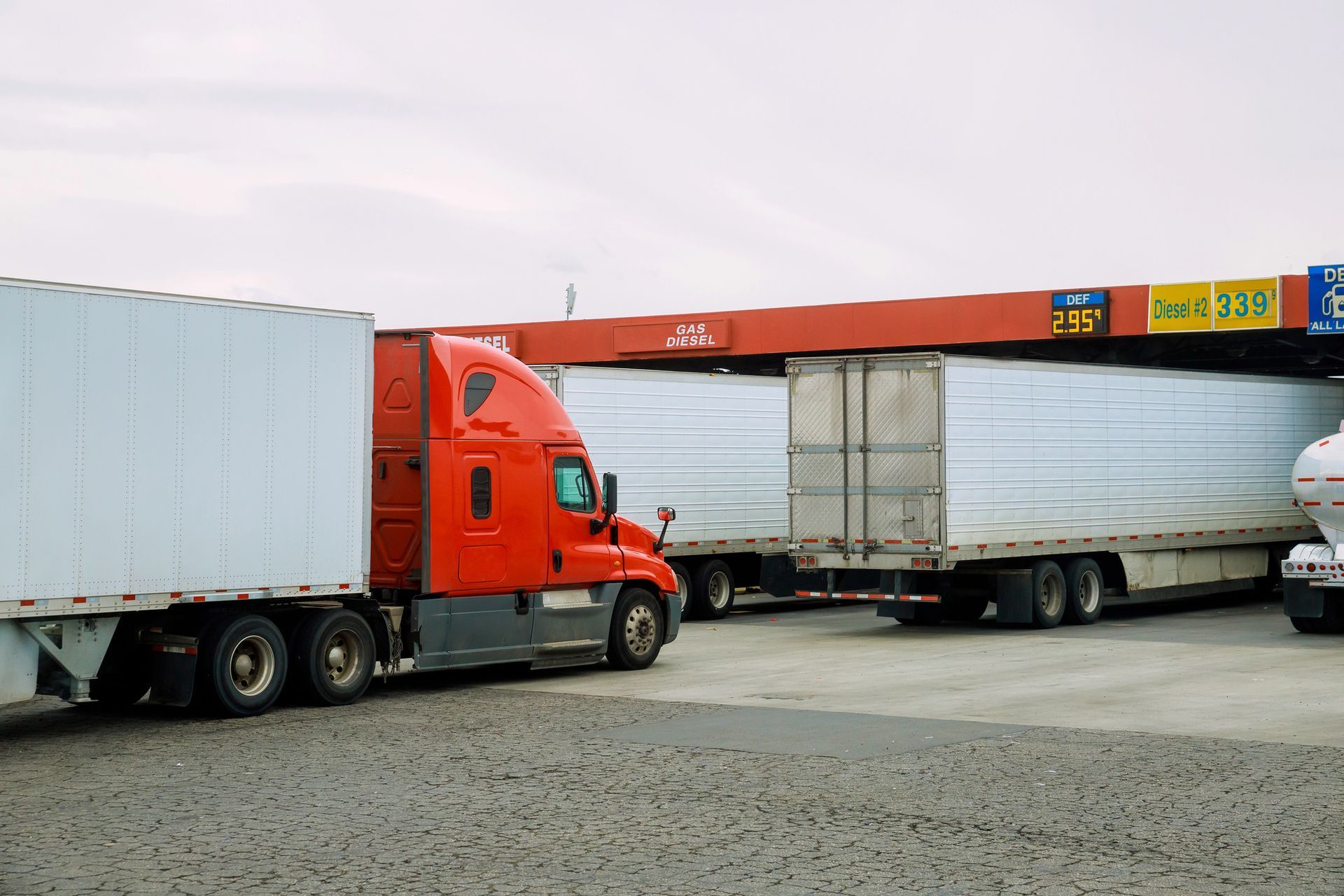How to Keep Your Diesel Fuel From Freezing
Diesel fuel gets cantankerous when the temperature plummets. Sometimes it stops flowing, sometimes it doesn't. Nervous drivers start pouring in fuel treatment when they hear the temperature is dropping: is it really necessary? And when all is said and done, did the additives help, or would the truck have kept running without help from a jug?

There should be no need to panic about fuel when it gets cold if you manage your fuel properly and take appropriate steps. Many don't, and they are the ones who get stung either with the added expense of on-road fuel treatment purchases or the inconvenience of a shut-down.
To successfully combat cold-related fuel problems, you have to understand what happens to fuel at low temperatures. First, let's clarify some of the terms used when discussing temperature's impact of diesel fuel:
- Gelling: Situations where the fuel literally turns to jelly are fairly rare. Gelling occurs when the paraffin wax in diesel solidifies because of a drop in temperature, and the temperature of the fuel generally has to stay below something like minus 10 degrees F for extended periods, like 48 to 72 hours. When cold soaked, the paraffin wax present in diesel solidifies, giving the fuel a cloudy appearance. The fuel can begin to cloud at temperatures as high as 32 degrees F, but it will continue flowing. The fuel must stay very cold for long periods before it will actually gel. It's not uncommon to hear drivers complain about their fuel gelling up, but that's probably not the actual problem they are experiencing. The more likely problem is ice or solidified paraffin wax in the fuel filter. More on that below.
- Cloud Point: There are prescribed tests to determine the cloud point of a sample of diesel fuel, which is the temperature at which the naturally present paraffin wax in #2 diesel fuel begins to crystalize. These tiny particles of suspended solidified wax give the fuel a cloudy appearance. Typical cloud point temperatures range from -18°F to +20°F but may be as high as +40°F — depending on a number of factors related to the base stock and refining processes used to make diesel fuel. So-called winter diesel fuel (#1 diesel or kerosene) contains very little paraffin and therefore has a significantly lower cloud point. Fuel distributors will test the product and may publish the results on tenders and delivery receipts if requested.
- Pour Point: This is the temperature below which a liquid loses its flow characteristics. With diesel fuel, the pour point can vary with the concentration of wax in the fuel, which varies with the source of the base stock, the refining process, and the type and quantity of additives that may have been introduced to the fuel during refining or distribution. There's always a spread between the cloud point and the pour point, with the latter usually from anywhere 2° to 20°F below the former. There are prescribed tests to determine the pour point of a fuel sample. As above, bulk suppliers can provide this information.
- Cold Filter Plugging Point: This is a measurement based on a standardized test that indicates the rate at which diesel fuel will flow through a standardized filtration device in a specified length of time when cooled. The point at which the sample fails to go through the filter within the specified time is the CFPP.
Water in Your Diesel = Ice in Your Veins
While "gelling up" may be a common phrase, it's probably not the real reason your truck no longer runs. The most likely culprit is water, or more aptly, ice.
Frozen water can clog fuel lines and fuel filters, which starves the engine of fuel. Water freezes at a much higher temperature than does fuel, so if you're experiencing problems at temps ranging from 20° to 30°F, you probably have ice in your fuel lines or fuel filters. Pop the filter off and look inside; ice looks like, well, ice, and frozen wax is thick and gooey.
Water is almost always present in diesel fuel to some degree. A substantial quantity can accumulate in storage tanks or truck tanks if it isn't removed periodically. Since water is heavier than fuel, it settles to the bottom of the fuel tank. You'd be okay if it stayed there, even frozen, but it never does. Warm fuel melts the water which then sloshes around in the tank when the truck is moving. That breaks it up into finer droplets that can freeze as it travels through fuel lines exposed to cold outside air.
"We really see the problems at the metal 90-degree-bend fittings in the fuel lines," says Darry Stuart, an independent, limited time executive, providing maintenance and operational expertise. He's also a very active member of ATA's Technology & Maintenance Council. "The metal is cold, the 90-degree bend slows the flow and water trapped there can freeze, eventually plugging the line. The same thing can happen with air lines when the air dryer isn't working, but that's another story."
Ice crystals that make it past a 90-degree bend will next hit the fuel filter filtration media. In the past, when filter media was measured in 10s of microns, tiny ice crystals easily passed through the media. With today's 2-micron filters, ice will be trapped by the filter. If enough ice accumulates on the filter media, fuel will no longer flow through the filter and the engine will quit.
Changing your filters to one with more porous media is not the answer. Today's high-pressure fuel injection systems have very tight internal clearances, and any debris can cause significant and costly damage. Were you to use a more porous filter, the ice that clogged the smaller filter would melt under the heat and pressure in the injection system long before it got to the sensitive injectors, but other particles present in the fuel would pass through too, possibly damaging the pump or injectors.
You can lessen your chances of being struck down by humble ice crystals by draining or vacuuming the water from your fuel tanks, both on board the truck and in the yard.
"That should be part of a late-year PM, before the temperatures begin dropping," says Stuart. "You get water in the fuel from many sources: from condensation [warm fuel/cold temperatures], sludge in the bottom of the storage tanks, poor quality fuel from truck stops. It's everywhere, and it's probably in your tanks too. You should also drain your fuel/water separators too."
Take Control of Your Fuel
Stuart insists that the only way a fleet can stay ahead of fuel problems in winter is controlling the supply.
"Diesel fuel is a commodity," he says. "The people in the fleet who purchase the fuel look only at the price, not what's being delivered. For nine months out the year, it really doesn't matter what you buy, save for the swings in quality and junk that comes in with the fuel, but you can't control that except by maybe switching suppliers. It's a different story in winter."
Stuart say fleets with northern exposure should blend kerosene into their regular diesel supply, even if the supplier already offers a winter blend.
"Blending kerosene into diesel fuel in cold weather is the only sure-fire way of avoiding fuel-related cold-weather problems," he swears.
Blending kerosene into #2 diesel fuel lowers the cloud point of the fuel, or the temperature at which the paraffin wax begins to crystalize.
"How do you think fleets in the northern states and Canada manage when it gets really cold?" he asks. "They use a winter blend of #2 diesel and kerosene, often sold as #1 diesel. Depending how far north they are located, kerosene blending usually starts in the fall and continues through the winter months and into spring. They hardly ever have problems with that fuel."
Why is kerosene blending Stuart's preferred method of preventing fuel-related downtime?
"It's measurable and predictable," he says. "We know from testing and experience that, for example, a 20% kerosene blend will lower the cloud point of fuel and keep you running in temperatures down to zero degrees Fahrenheit.
"Any fuel supplier can give you a pour-point chart, and they'll tell you, 'our fuel is good down to 18-below.' Okay, that's fine, but then ask the supplier if they are willing to pay all the associated costs if it doesn't work," Stuart says. "Usually you never hear from them again."
Somebody is going to pay if the temperature dips down to minus-18 and the winter fuel or the additives you bought don't work. To those who believe kerosene is too expensive, compare that to the cost having a significant portion of your fleet sitting on the side of the road due to frozen fuel.
Balancing Price Against the Cost of Not Being Able to Run the Truck
"I grew up in Massachusetts, and fleets around here preferred using additives rather than kerosene blending," says Ben Curtis, fleet maintenance supervisor for the Delta Bulk Transport division of J.P. Noonan Transportation. "Kerosene was shunned because it was expensive, had lower BTU than diesel [poorer fuel mileage] and less lubricity. Blending with kerosene wasn't something I was accustomed to doing."
Then, over the Christmas holiday a few years back (working for a different carrier), a cold front moved across New England and temperatures sank into the single digits. What's worse, because the equipment sat for a few days, the fuel in the tanks became cold soaked.
"It was a mess," Curtis recalls. "The fuel had chilled to ambient temperature and had begun to cloud (the wax had crystalized), and the fuel filters were plugged. I called Darry (Stuart) and he advised me to pour kerosene into the tanks with a best estimate of the blend for the temperature, and to get some kerosene into the fuel filters to dissolve the wax. We did that and it worked."
The lesson Curtis learned from that experience was not to compare the cost of kerosene against the cost of an additive program, but to the cost of not being able to run the truck.
"I was worried about lubricity value and BTU value, but my trucks weren't running, and my customers were pretty unhappy," he says. "Since then, I have been ordering my fuel cut with kerosene in varying percentages based on projected temperatures."
Stuart says various fuel additives such as pour-point suppressants and anti-gelling products can work, but he takes issue with the usual lack of performance guarantees.
"Like with the fuel suppliers, try getting an additive supplier to back up their claims with a guarantee that they will pay the cost of getting the trucks back on the road if the product fails to prevent a freeze-up," he says. "It's probably not going to happen."
Stuart's position is, if you're spending money to protect yourself and that investment falls short, you're throwing money away. Instead, he says, "Take control of your fuel destiny; do it yourself. Start ordering your own kerosene-blended fuel around December 1, depending where you live in the country and how cold it's likely to get, and continue monitoring the weather forecasts for warnings of extreme dips in temperature."
For fleets with their own fuel pumps, Stuart supplied the chart below with his recommendations for winter blending of diesel with kerosene. Bear in mind, product must be ultra-low sulfur kerosene, which differs from Jet A (basically kerosene), which is not ultra-low sulfur. Fuel suppliers will provide test results on samples of the fuel they sell if you ask. As above, the results will show the cloud point and perhaps the cold filter plug point. Even if those numbers are within your requirements, Stuart says the fuel is probably fine, but cautions that you won't get a performance guarantee from the fuel supplier.
"If you want a guarantee, do it yourself," he says.

Understanding fuel system problems and their symptoms makes finding solutions easier. Darry Stuart provided these guidelines to help fleets understand what happening to their fuel and how to fix it.
Content Disclaimer: Due to the constantly changing nature of government regulations, it is impossible to guarantee the total and absolute accuracy of the material contained herein or presented. NorthAmerican Transportation Association (NTA) cannot and does not assume any responsibility for omissions, errors, misprinting or ambiguity contained. NTA shall not be held liable in any degree for any loss, damage or injury caused by any such omission, error, misprinting or ambiguity present. It is made available with the understanding that NTA is not engaged in rendering legal, accounting or other professional service. If legal advice or other expert service is required, the services of such a professional should be sought.











